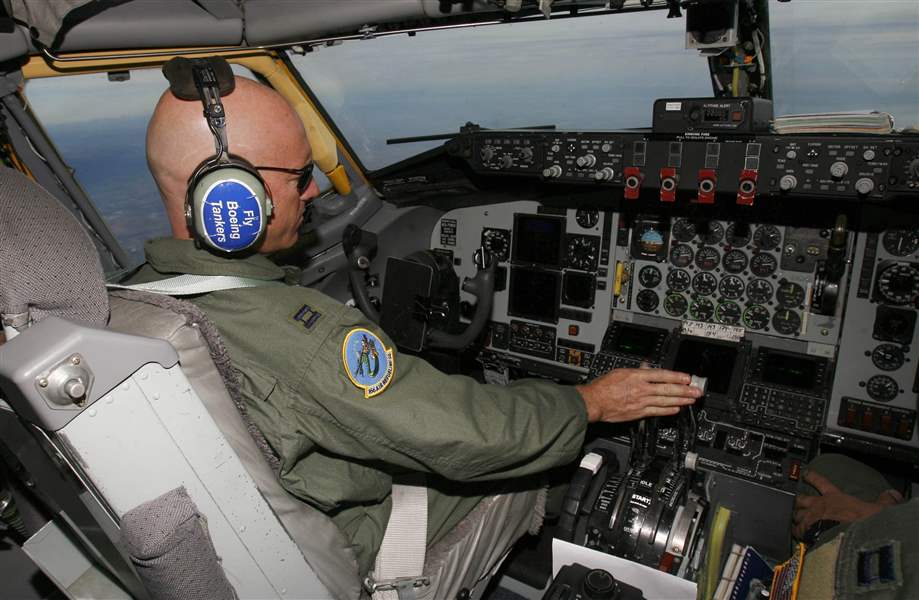
Ohio Guard pilots, crew gas and go in a hurry
11/2/2009
Capt. Rob Cruea guides a KC-135 tanker toward a refueling rendezvous with F-16s from Toledo. Captain Cruea is with the 121st Air Refueling Wing.
The Blade/Amy E. Voigt
Buy This Image
Watching a sleek F-16 fighter jet pull up within a few feet of a tanker aircraft flying at 21,000 feet is a bit of a Hollywood moment.
As the fighter pilot's eyes remain fixed on a bright yellow stripe painted along the underbelly of the tanker, a 20-foot boom extending from the back of the airborne gas station finds its mark over the jet's refueling port.
The jet hangs in the air without a quiver as a nozzle at the end of the boom connects with the port.
One minute and 1,000 gallons of gas later, the fighter jet banks to the right and disappears from view.
Mission accomplished.
"The first thing our flight manuals say is: It's inherently dangerous to fly two aircraft in close proximity," Senior Master Sgt. Daniel Toskin said. "That's what we do when we refuel planes in flight."
For boom operators such as Sergeant Toskin and the pilots of both the tanker and the fighter jet, in-flight refueling is a highly skilled, yet routine, maneuver.
It's a technique used frequently on cross-country flights and, more importantly, on overseas flights and over desert and enemy space where landing to refuel simply isn't an option.

Capt. Rob Cruea guides a KC-135 tanker toward a refueling rendezvous with F-16s from Toledo. Captain Cruea is with the 121st Air Refueling Wing.
"This is how we make it overseas," explained Lt. Col. Michael Timbrook, a fighter pilot with Toledo's 180th Fighter Wing. "We take off from here, and it's a 10 to 15-hour flight, so we fly behind a tanker."
On deployments, keeping the fighter jets light on fuel is a necessity. As Senior Master Sgt. Sam Given put it, the less fuel a fighter jet or bomber has onboard, the more bullets and bombs it can carry.
Over a patchwork of fields high above south central Ohio one day last week, six F-16s from the 180th Fighter Wing of the Ohio Air National Guard appeared seemingly from nowhere for a rendezvous with a big, gray Boeing KC-135.
The tanker plane, circa 1963, is similar to a 707 airliner, but it's stripped down military-style.
No first-class seats, no overhead storage compartments, and just two tiny windows on each side of the cabin. Passengers sit along the sides of the cabin on a line of no-frills canvas seating.
Last week's exercise was carried out for an onboard audience of "bosses" who have employees in the National Guard. They were invited to spend the day at the guard base off Eber Road near Swanton.
Capt. Gary Bentley, executive officer for the 180th, said the two-hour flight and refueling exercise was more than a public relations stunt, though.
"We're not doing this just to do this," he said. "We practice refueling regularly. It's part of the required training both for the KC-135 pilots and crew and the pilots of our fighters."
While the massive
KC-135s are frequently used to carry troops and cargo when a Guard unit is deployed overseas, their primary purpose is to carry fuel - lots of fuel.
"We can hold 200,000 pounds totally full," said Capt. Rob Cruea, who piloted the tanker. "We can use it or we can give it away."
Captain Cruea and his crew came up to Toledo from the National Guard's 121st Air Refueling Wing based at Rickenbacker Air Force Base near Columbus.
While the 180th consists of fighter jets, the 121st is dedicated to refueling aircraft in flight.
The practice was done experimentally as far back as the 1920s but did not come into widespread use by the U.S. Air Force until after World War II. The Boeing KC-135 was first used as a dedicated tanker aircraft in the 1950s and remains the favored refueler.
The tankers flown by the 121st today were built between 1957 and 1964. They're old, the crew says, but well-maintained.
Sprawled on his stomach in the plane's boom pit in the rear of the plane, Sergeant Toskin points out the gauges and levers he uses to lower and raise the boom and make the necessary connection to the aircraft that pulls up just outside the eye-level window for refueling.
"It's all basically 1950s technology," he said. "It's all pretty much eyeballs."
The guests for the day take turns descending to the pit where they get the view of their lives.
"It's awesome. Not many people get to see this," said Michael Cramer of Waterville, who was on the flight from Owens-Corning. "It's amazing people do this for a living and some of them are part-time."
That was exactly the sentiment the National Guard and an organization known as Employer Support of the Guard and Reserve hoped employers would glean from the experience. They want them to realize that when their employees leave work for Guard duty or deployment, they're far more than weekend warriors.
"We try to do this three or four times a year," said Col. Mark Bartman, wing commander at the 180th. "We feel it's extremely important for members of the community to see what we do in the military and especially in the 180th."
Contact Jennifer Feehan at:
jfeehan@theblade.com
or 419-724-6129.